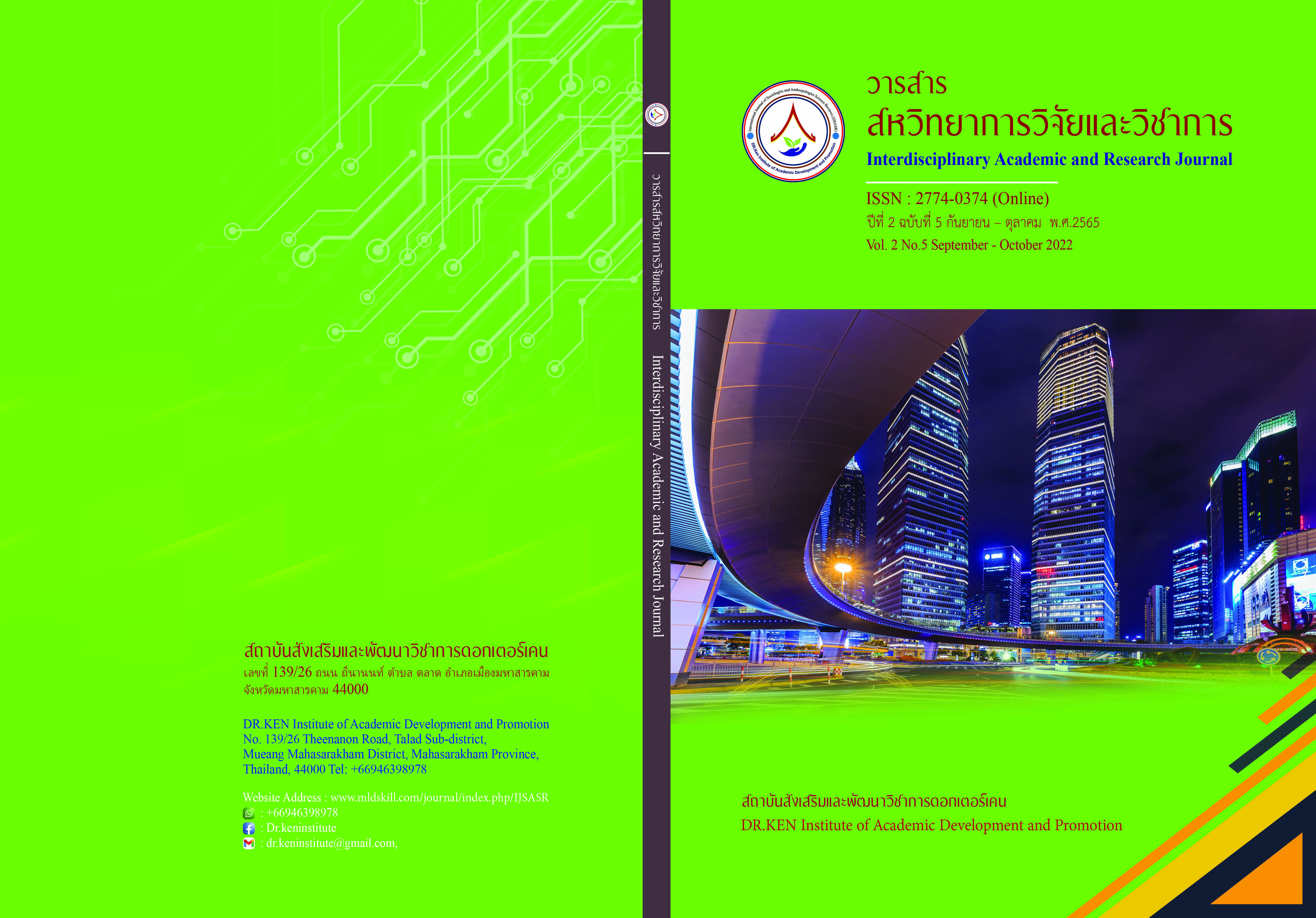Waste Water Management based on the Community Groundwater Bank Model at Ban Khok Kong, Non-Sa-at Subdistrict, Khon Sawan District, Chaiyaphum Province
DOI:
https://doi.org/10.14456/iarj.2022.83Keywords:
Wastewater Management; , Groundwater Bank Model; , Participatory ProcessAbstract
Water is an extremely important resource for plants, animals and humans on Earth. Water is used for consumption, cultivation and animal husbandry. Therefore, there is always an impact from water utilization such as wastewater problems caused by humans. There should be an appropriate process of wastewater treatment before it is discharged into natural water sources. For this reason, this research focused on the development of the groundwater bank system to create the wastewater management system based on the underground water bank model suitable for all areas that need to use this model for wastewater management. The objectives of this research were: (1) The original community wastewater management system and the wastewater management system based on the groundwater bank model; 2) to implement the wastewater management in the community based on the groundwater bank system and 3) to assess the wastewater management based on the groundwater bank system using the qualitative research method, which was participation action research (PAR). The concepts and theories of the open and closed groundwater bank systems, the drainage construction, the participatory process, the wastewater management, the water management, and the development were used as the research framework. The research area was Ban Khok Kong, Non Sa-at Sub-district, Khon Sawan District, Chaiyaphum Province. There were 30 samples, consisting of the village headmen, the village committees, the members of Sub-district Administrative Organization and the representatives of each community from each village. They were selected by a purposive sampling method. The research tools consisted of three parts: in-depth interviews; focus group discussions and workshops. The qualitative data were analyzed by content analysis the following process: 1) data reduction, 2) data organization and 3) data interpretation to conclusion. (2) The wastewater management process meeting the water management standards has not been found. Most villagers have constructed the drainage ditches out of their houses, and wastewater is released into natural waterways beside the road. In some areas, the drainage ditches have been constructed in front of the houses to release wastewater into natural water sources. Only few households have wastewater disposal wells in their own areas. In terms of the provision of the knowledge on the wastewater management system based on the groundwater bank model, people in the community have a good understanding about the wastewater management system and they are ready to carry it out. (3) According to the survey of the area conditions for the preparation of the groundwater bank model, the field surveys were used to investigate the direction of the water flow and the point where water flows together in order to plan for the drainage constriction based on the groundwater bank model. After the road conditions, the roadside ditches, and the soil layers had been surveyed, “the drainage with dual manholes based on the groundwater bank system” was constructed for experimenting in the pilot area with the following sizes: 1. the main manhole: Width x Length x Depth = 1.20x1.20x2.00 meters; 2. the secondary manhole: Width x Length x Depth = 0.50x0.50x1.00 meters; 3. the water gutter: Width x Length x Depth = 0.50x5.00x0.50 meters and 4. the center of the main manhole: Width x Length x Depth = 0.50x0.50x0.30 meters. However, the conditions before and after the construction of the drainage with dual manholes based on the groundwater bank system were assessed. It was found that before the operation the three drainage areas faced the problems of flooding, smelly water and water flowing into the private areas of the community. However, after the construction of the drainage with dual manholes based on the groundwater bank system, the problems can be solved concretely. The community also needs the relevant agencies and the local administrative organizations to allocate budgets to develop the groundwater bank system around the entire village in order to sustainably solve the sewage and wastewater problems.
The knowledge gained from the wastewater management based on the groundwater bank model by community participation process of Ban Khok Kong, Non Sa-at Sub-district, Khon Sawan District, Chaiyaphum Province can be used as a model for the management of wastewater and flooding in the areas with narrow roads and limited spaces. The process is not complex. Local government organizations can immediately implement this model in the areas with the same problem.
References
กรุงเทพธุรกิจ. (2563). ธนาคารน้ำใต้ดิน ทางรอดภัยแล้ง - น้ำท่วมขัง. [Online]. แหลงที่มา: https://www.bangkokbiznews.com/news/detail/881579 [31 สิงหาคม 2563].
เกษม จันทร์แก้ว. (2541). วิทยาศาสตร์สิ่งแวดล้อม. กรุงเทพฯ: มหาวิทยาลัยเกษตรศาสตร์.
เทคโนโลยีชาวบ้าน. (2562). สร้าง “ธนาคารน้ำใต้ดิน” ฝากน้ำกับดิน แก้ปัญหา น้ำท่วม-ภัยแล้ง ในแปลงไร่นา. [Online]. แหล่งที่มา: https://www.technologychaoban.com/bullet-news-today/article_118534. [7 สิงหาคม 2562].
นริศริน พันธเพชร, สมิหรา จิตตลดากร. (2564). รูปแบบการจัดการโครงการธนาคารน้ำใต้ดินอย่างยั่งยืนของจังหวัดยโสธร. วารสารสังคมศาสตร์และมานุษยวิทยาเชิงพุทธ. 6 (3), 92-107.
บุญชม ศรีสะอาด. (2560). การวิจัยเบื้องต้น. พิมพ์ครั้งที่ 10. กรุงเทพฯ : สุวีริยาสาส์น.
ปธาน สุวรรณมงคล. (2540). การพัฒนาประสิทธิ ภาพการบริหารจัดการทรัพยากรน้ำ. รายงานการวิจัยโครงการปรับภาคราชการสู่ยุคโลกาภิวัตน์. กรุงเทพ ฯ : โรงพิมพ์กองกลางสำนักคณะกรรมการข้าราชการพลเรือน.
ปิยธิดา ศรีพล, รัชดา ภักดียิ่ง, พรสวรรค์ ชัยมีแรง, รุ่งนภา กิตติลาภ และ อณพสิษฐ์ ไชยเชษฐ์. (2563). แนวทางการจัดการน้ำเสียบึงหนองโคตรของเทศบาลตำบลบ้านเป็ด อำเภอเมือง จังหวัดขอนแก่น. วารสารวิชาการและวิจัย มหาวิทยาลัยภาคตะวันออกเฉียงเหนือ. 10 (2), 124-136.
สันติชัย เท่าสิงห์, สุทธิพงษ์ สุทธิลักษมุนีกุล, และ ประสิทธิ์ กุลบุญญา. (2563). การบริหารจัดการธนาคารน้ำใต้ดินเพื่อการเกษตร: กรณีศึกษาองค์การบริหารส่วนตำบลยางขี้นก อำเภอเขื่องใน จังหวัดอุบลราชธานี. Journal of Humanities & Social Sciences. 18 (3), 43-64.
เสรี พงศ์พิศ. (2563). ธนาคารน้ำใต้ดิน. [Online]. แหล่งที่มา : https://siamrath.co.th/n/99354 [31 สิงหาคม 2563].
Tathongduang, C. (2013). Regal problems relating water management of the stage in Thailand. A thesis for the degree master of Laws. Department of law. Pridi Banomyong Faculty of Laws. Bangkok: Dhurakij Pundit University.
Downloads
Published
How to Cite
Issue
Section
License
Copyright (c) 2022 Prasit Nonthasen, Pramuk Srichaiwong, Kamonphun Nonthasen

This work is licensed under a Creative Commons Attribution-NonCommercial-NoDerivatives 4.0 International License.
Copyright on any article in the Interdisciplinary Academic and Research Journal is retained by the author(s) under the under the Creative Commons Attribution-NonCommercial-NoDerivatives 4.0 International License. Permission to use text, content, images, etc. of publication. Any user to read, download, copy, distribute, print, search, or link to the full texts of articles, crawl them for indexing, pass them as data to software, or use them for any other lawful purpose. But do not use it for commercial use or with the intent to benefit any business.
















.png)


